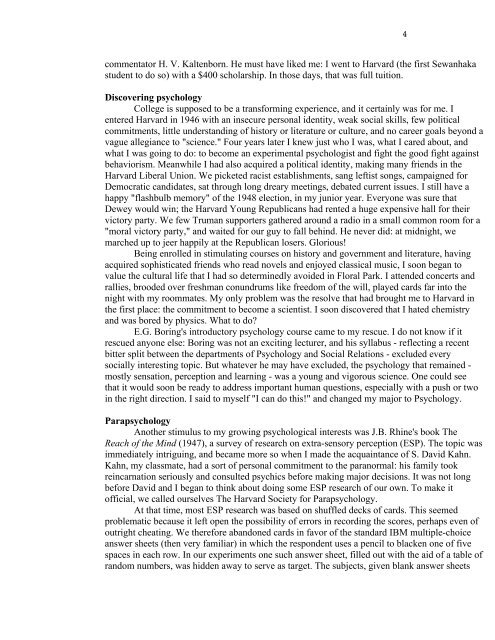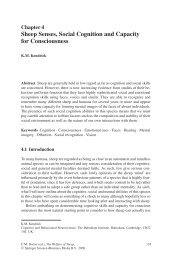Ulric Neisser
Ulric Neisser
Ulric Neisser
You also want an ePaper? Increase the reach of your titles
YUMPU automatically turns print PDFs into web optimized ePapers that Google loves.
commentator H. V. Kaltenborn. He must have liked me: I went to Harvard (the first Sewanhaka<br />
student to do so) with a $400 scholarship. In those days, that was full tuition.<br />
Discovering psychology<br />
College is supposed to be a transforming experience, and it certainly was for me. I<br />
entered Harvard in 1946 with an insecure personal identity, weak social skills, few political<br />
commitments, little understanding of history or literature or culture, and no career goals beyond a<br />
vague allegiance to "science." Four years later I knew just who I was, what I cared about, and<br />
what I was going to do: to become an experimental psychologist and fight the good fight against<br />
behaviorism. Meanwhile I had also acquired a political identity, making many friends in the<br />
Harvard Liberal Union. We picketed racist establishments, sang leftist songs, campaigned for<br />
Democratic candidates, sat through long dreary meetings, debated current issues. I still have a<br />
happy "flashbulb memory" of the 1948 election, in my junior year. Everyone was sure that<br />
Dewey would win; the Harvard Young Republicans had rented a huge expensive hall for their<br />
victory party. We few Truman supporters gathered around a radio in a small common room for a<br />
"moral victory party," and waited for our guy to fall behind. He never did: at midnight, we<br />
marched up to jeer happily at the Republican losers. Glorious!<br />
Being enrolled in stimulating courses on history and government and literature, having<br />
acquired sophisticated friends who read novels and enjoyed classical music, I soon began to<br />
value the cultural life that I had so determinedly avoided in Floral Park. I attended concerts and<br />
rallies, brooded over freshman conundrums like freedom of the will, played cards far into the<br />
night with my roommates. My only problem was the resolve that had brought me to Harvard in<br />
the first place: the commitment to become a scientist. I soon discovered that I hated chemistry<br />
and was bored by physics. What to do?<br />
E.G. Boring's introductory psychology course came to my rescue. I do not know if it<br />
rescued anyone else: Boring was not an exciting lecturer, and his syllabus - reflecting a recent<br />
bitter split between the departments of Psychology and Social Relations - excluded every<br />
socially interesting topic. But whatever he may have excluded, the psychology that remained -<br />
mostly sensation, perception and learning - was a young and vigorous science. One could see<br />
that it would soon be ready to address important human questions, especially with a push or two<br />
in the right direction. I said to myself "I can do this!" and changed my major to Psychology.<br />
Parapsychology<br />
Another stimulus to my growing psychological interests was J.B. Rhine's book The<br />
Reach of the Mind (1947), a survey of research on extra-sensory perception (ESP). The topic was<br />
immediately intriguing, and became more so when I made the acquaintance of S. David Kahn.<br />
Kahn, my classmate, had a sort of personal commitment to the paranormal: his family took<br />
reincarnation seriously and consulted psychics before making major decisions. It was not long<br />
before David and I began to think about doing some ESP research of our own. To make it<br />
official, we called ourselves The Harvard Society for Parapsychology.<br />
At that time, most ESP research was based on shuffled decks of cards. This seemed<br />
problematic because it left open the possibility of errors in recording the scores, perhaps even of<br />
outright cheating. We therefore abandoned cards in favor of the standard IBM multiple-choice<br />
answer sheets (then very familiar) in which the respondent uses a pencil to blacken one of five<br />
spaces in each row. In our experiments one such answer sheet, filled out with the aid of a table of<br />
random numbers, was hidden away to serve as target. The subjects, given blank answer sheets<br />
4




